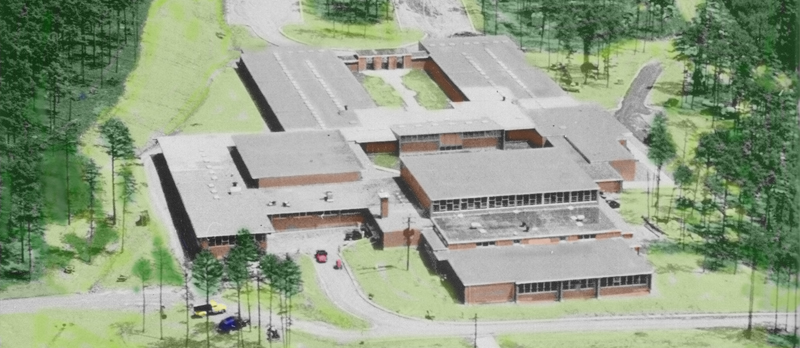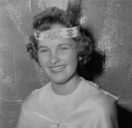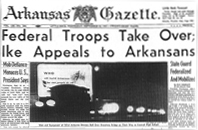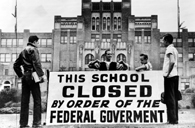 |
 |
|
|
|
|
| Prior to 1957 there were, at most, four high schools in Little Rock, Arkansas. But the city was growing, and it was growing to the west -- as it continues to do today -- so the Little Rock School Board decreed that another high school be constructed among the tall pines just west of what is now University Avenue. The new school was named for Colonel Robert Cleveland "R.C." Hall, superintendent of the Little Rock School District from 1909 to 1941. Its doors opened in the fall of 1957. |

|

|
We were a part of the first student body to walk the halls, so we were privileged to do what few students ever get to do. By majority vote, we selected the school mascot, the Warriors; selected the colors, orange and white; and wrote the alma mater. The band, under the direction of Merel Boyce, selected the band uniforms. Head football coach Ray Peters, basketball and swimming coach J. D. McGee, and track coach Bill Kessinger fielded the first varsity sports teams. We inaugurated the school newspaper, The War Whoop, and we printed the first yearbook, The Warrior, for which Pat Boone selected the first Warrior Beauty, Donna Sue Martin. We elected Porter Briggs the first student body president, and each class elected the first class representatives to the first student council. |
| To add to our uniqueness, in 1957 there was no Homecoming Queen. The reason? It was Hall High School's first year of existence, and since there were no graduates there could be no homecoming. Instead, Martha Young reigned as the Football Queen. Then, as you shall read, there was no school in the school year 1958-1959, so the first official homecoming was delayed until the 1959 football season. Therefore our class, the class of 1960, elected Hall High School's first official Homecoming Queen, Carol Sue Cruse. |

|

|
The now defunct Pontiac Motor Division of General Motors Corporation was still a major player in the automobile market, and the primary Pontiac dealer in Little Rock was Dumas Milner Pontiac on West Capitol Street downtown. In their showroom stood a larger-than-life-sized statue representing the Native American Ottawa Chief Pontiac, for whom the city of Pontiac, Michigan, and therefore the automobile division, were named. When "the Warriors" was selected as the Hall High School mascot, Dumas Milner donated the statue to the school. It was christened "Wakndah" -- pronounced Wa(h)-k(i)n-dah -- which means "Spirit of the West Wind". Wakndah forever stands guard in the entrance foyer. |
| All of that done, we got down to the business of education. | |
| As sophomores, we should have been the first class to graduate having spent our entire high school experience at Hall. But it was not to be. Four miles to the east, the ominous clouds of what has become world renown as "The Little Rock Integration Crisis" were darkening at Little Rock Central High School. We will not recycle those events here. (Google "Little Rock Nine", with the quotes, and you will get over 100,000 hits and you can read and study to your heart's content.) What we will say, is that it had little effect on us in the 1957-1958 school year. After all, we were "the other high school". |

|

|
Then, in the fall of 1958, the firestorm struck all over Little Rock. All of the high schools were closed -- not by the Federal Government (despite the protest sign), but by order of Governor Orval Faubus. Suddenly 3,698 students were left with no means of continuing our education. The scramble was on. We went to the already crowded county schools, or to live with relatives in other cities and even other states, or to the quickly-established private T.J. Raney High School. Some went into the military services, some colleges accepted the best and brightest directly into their freshman classes, some families moved away, and some students, having no other option, laid out a year. The class of 1959 was denied the opportunity to graduate together, and they are referred to as "The Lost Class", and because we all were so dramatically affected the school year 1958-1959 has become known as "The Lost Year". Sandy Hubbard (class of 1960) has created a website documenting the troubled times of 1958-1959, and you can go there by clicking HERE. |
| In the fall of 1959 the schools reopened, and the class of 1960 reassembled at Hall. But it was not complete. Many of us had known each other since childhood and had been together since grammar school. But torn asunder the previous year, many did not return. Parents, fearing the same riots at Hall that were still occurring at Central High, made their children stay whereever they were. There were, after all, federal troops surrounding the Hall High campus just as at Central High. For many students the high school experience was mixed. We went to class, we got our diplomas, and we moved on, but our loyalties were divided. |

|
|
Here, in the pages of this website, the entire Hall High School Class of 1960 is together once again.
|
 |